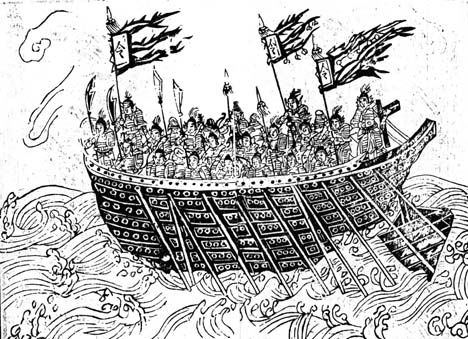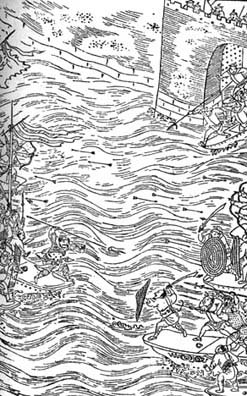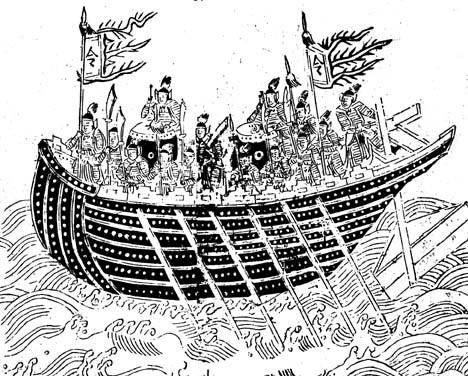
|
China has one of the longest histories of shipbuilding. The square ship in the Warring States era was already double-bodied and made up of two junks secured together side by side. Third century warships had eight compartments. Paddle-wheel boats were invented in the late Tang and widely used in the Song. |
|||||
|
The Southern Song navy was much larger and comparatively stronger than that of the Northern Song, mainly because it needed to keep northern armies from crossing the Huai and Yangtze Rivers. The navy had both small ships such as those on the left and larger vessels like those shown below. A strong navy of an attacking army could come right up to a riverside city. If a ship's deck was high enough, soldiers could step from it to the top of the city's wall. What might be other advantages and disadvantages of large and small ships? |
|||||
|
Small boat approaching a walled river city
|
|||||
|
"Sea hawks," as the type of ship below was called, were invented in the Tang and had floating boards on each side to stabilize the ship. By the Song, sea hawks usually had four to six boards on each side. (In the picture below, it is difficult to distinguish the oars from these boards.) Song ships were also strengthened with iron in the hull. Some had several decks to keep the ship steady. |
|||||
|
What role do you think ships might have had in siege warfare? |
|||||
|
"Sea hawk" warship
|
|||||
|
Compare the "sea hawk" ship above with the warship depicted below. What would be the advantage of the ship below? |
|||||
|
|
|||||
|
|||||
|
Song battleships were equipped with fire-bomb catapults and incendiary arrows that used gunpowder (discussed in other sections). Sometimes protected stations on upper decks were created for crossbowmen who also played the role of watchmen. |
|||||
|
To the left is a naval battle depicted in The Water Margin. Can you identify the weapons used here? What is different about the boats used here and those seen above? What about this scene might suggest a reason for the difference? |
|||||
|
Scene from The Water Margin
|
|||||
|
To the right is another type of warship from The Essentials of Military Arts. The word on the flag reads, "commander." Notice also the huge rudder.
What do you think is the purpose of the drums? |
|||||
|
|||||
|
Below to the left is a raft, to the right a floating bag. |
|||||
|
|
|
What would have been the military purposes of these items? What do you think they were made of?
|
|||
|
Bamboo raft
|
Floating bags
|
||||
|
Move on to Gunpowder and Firearms |
|||||
 The Song period
saw major advances in shipbuilding with improvement in speed, security
against foundering, adaptability to marine conditions, and steadiness.
The Song period
saw major advances in shipbuilding with improvement in speed, security
against foundering, adaptability to marine conditions, and steadiness. 




